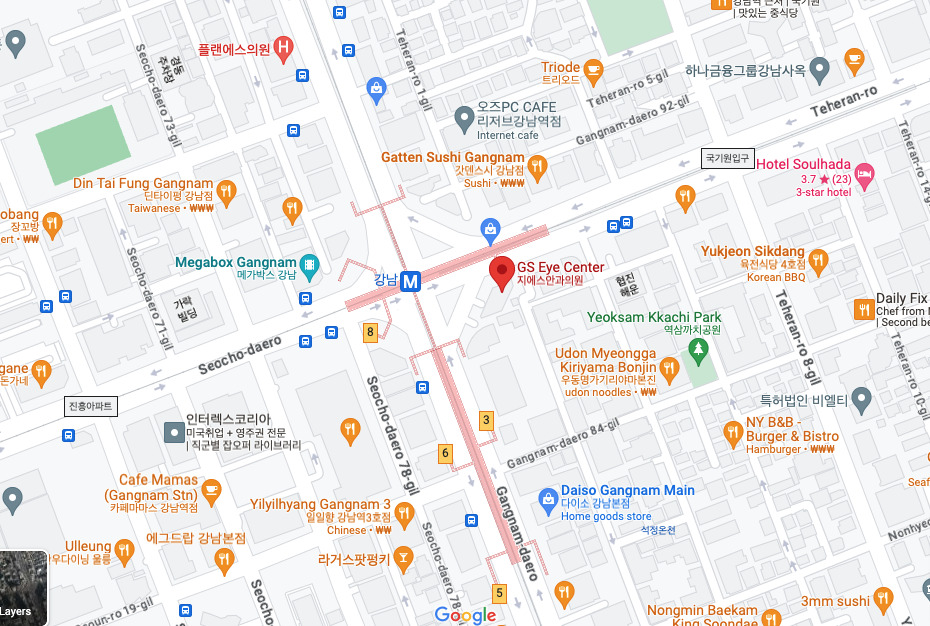The eye is a sensory organ that receives light as a stimulus and projects the surrounding objects to the brain. As a result, we can see and feel various things. Recently, the use of electronic devices such as TVs, computers, and smartphones has increased rapidly, causing vision to deteriorate and presbyopia to occur earlier. As a result, cataracts and presbyopia symptoms are now occurring not only in middle-aged people in their 40s and 50s, but also in people in their 20s and 30s. Today, we will discuss presbyopia vs cataract, how to do a cataract self-test, and how long does vision stay blurry after cataract removal by laser surgery.
1. Presbyopia and cataract self-test
1) Presbyopia
Presbyopia, which means “aging eyes,” is a condition that occurs as people age and is characterized by the symptoms of presbyopia, in which people can see well at a distance, but near objects are blurry. When vision is normal, the lens of the eye contracts to allow for near vision. As the eye ages, the muscles that hold the lens in place, as well as the lens itself, deteriorate, causing the eye to lose control. This results in the symptoms of presbyopia, which are blurry near vision.
Presbyopia usually starts after the age of 40 and can cause eye pain, headaches, and frown lines. Because of this, if you find it difficult to read or see letters clearly when reading or working at close range, such as on your smartphone or computer, you may want to consider wearing presbyopia contacts like glasses. Also, because presbyopia is an ongoing process, it’s a good idea to change your presbyopia contacts periodically.
2) Cataract
A cataract is a clouding of the lens of the eye that impairs vision. It is one of the most common age-related eye diseases.
When light enters the human eye, it is refracted through the lens and deposited on the retina. Cataracts occur when the lens that does this becomes cloudy, preventing light from penetrating properly, resulting in blurred vision and decreased vision. There are two main types of cataracts: congenital cataracts, where the cause is unclear, and acquired cataracts, which develop later in life as people age. Acquired cataracts are rarely caused by trauma or inflammation of the eye, but the symptoms of cataracts are the same no matter what the cause.
In the early stages of cataract development, medication can slow down the process, but the already cloudy lens will not clear up again, and you will eventually need to have the cataract removed by laser surgery. Cataracts are also often accompanied by presbyopia, which occurs when the tissues in the lens harden and you suddenly see things at close range clearly. For these reasons, it’s a good idea to have regular eye exams to check your eye health.
3) Presbyopia and Cataract Self-Test
Symptoms of presbyopia include difficulty seeing things clearly when reading in the dark or looking at small print, such as on a smartphone, which can cause you to feel tired easily and complain of headaches.
Cataracts, on the other hand, cause you to see more than one object or have difficulty focusing your eyes. You may also experience glare and light flashes, have difficulty driving at night, or suddenly feel as if your vision has improved because you can see objects at close range. If you experience any of these symptoms, you should have your cataracts checked, and depending on your doctor’s diagnosis, you may require cataract removal by laser surgery.
The easiest way to self-test for cataracts is as follows: cover one eye and extend your index finger and hold it in front of you. If, after a few moments, that finger appears to be two fingers, you may have presbyopia vs cataract. While this cataract self test makes it easy to tell, we recommend that you check your eye health regularly, as presbyopia and cataracts are often confused or accompanied by symptoms.
[cataract self test]- I see an object as 2 or more (diplopia).
- My vision is out of focus.
- I experience light sensitivity and glare.
- I feel difficulty driving at night.
- My vision suddenly seems to have improved.
👉 Cataracts surgery and Presbyopia | Symptoms, Diagnosis, and Treatments
2. presbyopia and cataract surgery
출처: Freepik
PRESBYOPIA VS CATARACT If you only have symptoms of presbyopia, this can be improved with LASIK PRESBYOPIA CORRECTION. If your symptoms do not improve with PRESBYOPIA CONTACT LENSES, we will perform surgery to improve your vision using an advanced laser surgery, “Monovision” equipment.
CATARACT If cataracts have been identified through the cataract self-test and close examination, surgery such as cataract removal by laser surgery may be required. In this case, we will perform either micro-incision cataract surgery or intraocular lens implantation. The advantage of micro-incision cataract surgery, which is usually performed for patients with cataracts, is that the cataract removal by laser surgery is performed using the Centurion equipment, so you can return to your daily activities the next day.
If you have presbyopia and cataracts at the same time, you may have a combination of presbyopia correction and cataract removal by laser surgery. In this case, you will undergo a procedure called IOL implantation, which is the insertion of a monofocal or multifocal intraocular lens.
A monofocal intraocular lens improves distance vision by operating on the lens that is clouded by cataracts, but it can only focus on either near or far. Multifocal IOLs, on the other hand, improve both distance and near vision by correcting presbyopia and cataracts at once, and can focus on both distant and near objects. The right lens for you and how long does vision stay blurry after cataract surgery will vary from patient to patient, so you’ll need to discuss this with your doctor after your exam.
3. Presbyopia and cataract surgery precautions
출처: Freepik
While both of these surgeries have low rates of side effects, both presbyopia vs cataract have common post-operative precautions, including checking how long does vision stay blurry after cataract surgery. First of all, while you can go about your daily routine the next day, you need to take absolute rest on the day of surgery: washing your face and showering is a week after surgery, washing your hair is one month later, and strenuous exercise and bathing is two months later.
Also, eyelid care is essential after surgery, and neglecting it can lead to complications such as conjunctivitis and keratitis. Finally, alcohol and smoking should be avoided for one month after surgery.
While cataract removal by laser surgery and improving presbyopia symptoms are safe surgeries, as we’ve already discussed, side effects are not uncommon. Apart from how long does vision stay blurry after cataract surgery, if you experience blurred vision, pain, eye swelling, or further decrease in vision after surgery, you should visit your eye doctor immediately for treatment.
Also, many people ask if they don’t have to wear presbyopia contacts and reading glasses after having surgery to improve their presbyopia symptoms. Because presbyopia correction surgery is just about seeing things at close range a little better, it can delay the need for presbyopia contacts and reading glasses to some extent, but it doesn’t mean you won’t need to wear presbyopia contacts or reading glasses for the rest of your life. If you experience presbyopia symptoms again over time after surgery, you may want to start wearing presbyopia contacts or reading glasses in the interim.
4. Cost of presbyopia and cataract removal by laser surgery
출처: Freepik
If an intraocular lens is inserted during cataract surgery, the cost varies depending on the type of lens. Roughly speaking, Cataract surgery can range from $200 to $1000, depending on whether you need a monofocal or multifocal lens. The price may also vary depending on the individual and, but this can vary depending on the individual. Other questions such as presbyopia vs cataract surgery and how long does vision stay blurry after cataract surgery vary depending on the individual’s eye condition, so it is possible to estimate the cost by consulting with a specialist.
Cataract and presbyopia surgery, GS Ophthalmology!
GS Ophthalmology, a hospital specializing in cataract removal by laser surgery, has long been visited by celebrities. This confirms that GS Ophthalmology provides successful cataract removal by laser surgery with the right surgery and treatment for each patient.
GS Ophthalmology, which has been conducting eye surgery including cataract removal by laser surgery for a long time, always provides a comfortable environment. In addition, we have advanced surgical equipment and examination facilities to provide optimized surgery and examination for patients.
Everyone’s eyes are shaped and structured differently, so it’s important to find the best surgical method for you. At GS Ophthalmology, we always strive to find the most effective method for your individual condition based on a thorough examination to ensure the best results.
Today, we looked at presbyopia vs cataract, a typical eye disease that has recently appeared in middle-aged to young people in Korea. Eyes play an important role in allowing us to see and feel the world, so it is important to protect them without losing them. We recommend that you do a cataract self-test from time to time and visit your doctor if you experience any symptoms. It’s also a good idea to get regular eye exams after the 40s and 50s, as you’re more likely to develop eye diseases like cataracts, glaucoma, and macular degeneration.
What is Cataracts and how to treat Cataracts?
The Cataracts occurs when the natural lens at the back of the iris and pupil becomes cloudy. The most effective way to treat cataracts is to under go cataract surgery to restore vision by removing and replacing the cataract-affected lens with an artificial one.
How much does eye surgery in Korea cost?
According to the Medical Tourism site's chart, Korea ranked second as the best destination for laser eye surgery because of its advanced technology and affordable price. The total cost for both eye surgeries in Korea is lower than that in other countries. Don't hesitate to contact GS Eye Clinic via our KakaoTalk Channel for more information about the total price of eye surgery in Korea.
Where should I get my eye surgery in Korea?
GS Eye Clinic in Seoul, Korea, is at the forefront of the latest technological advancements in laser eye surgery, including cataract surgery, Smile Lasik, and Lasek. Please schedule a consultation with GS Eye Clinic today to explore your options via our KakaoTalk Channel or visit us at 8,15,16F, Mizin Plaza, 390 Gangnam-daero, Gangnam-gu, Seoul, Korea.
GS Ophthalmology Center
Directions 8,15,16F, Mizin Plaza, 390 Gangnam-daero, Gangnam-gu, Seoul, Korea












